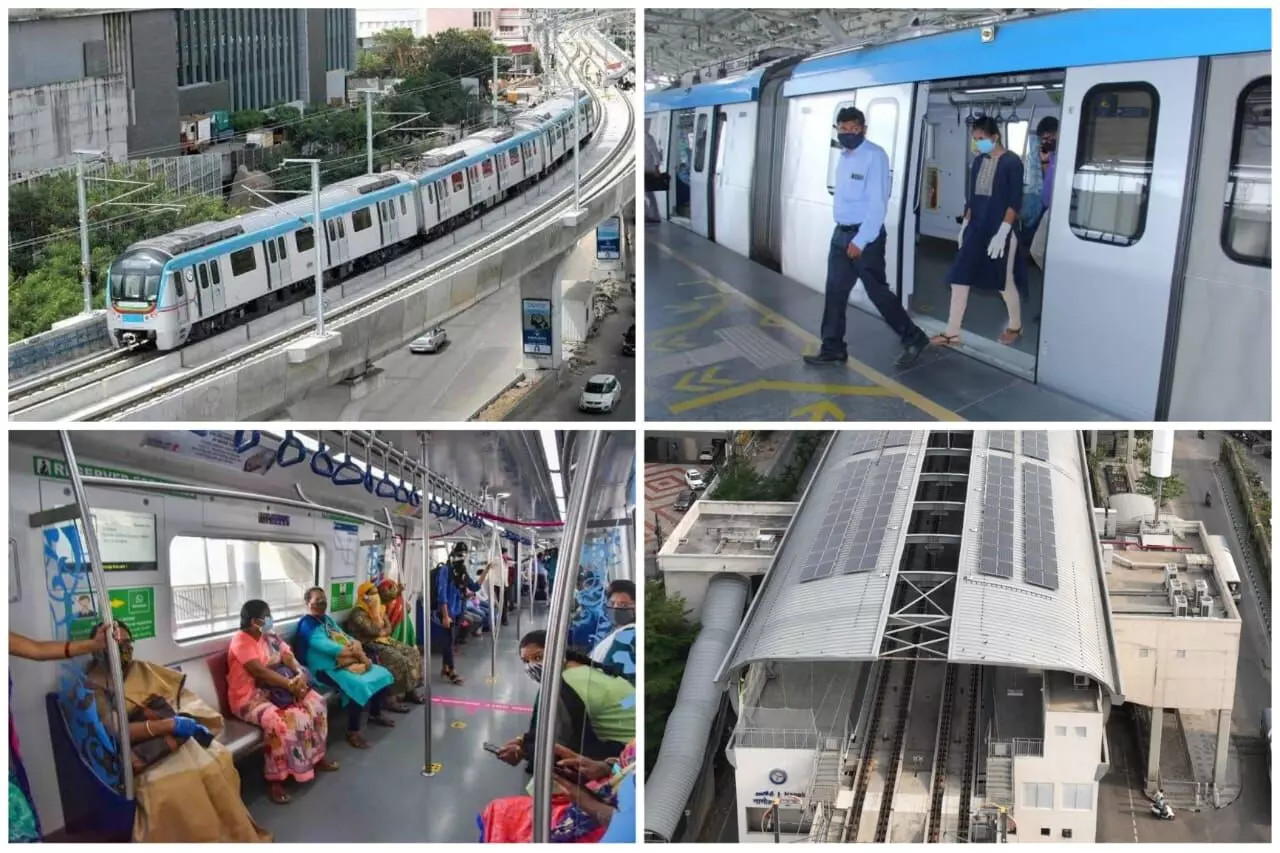Hyderabad metro@5: Take a look at HMRL's milestones, achievements
On 28 November 2017, Prime Minister Narendra Modi dedicated a 30-km stretch from Miyapur to Nagole with 24 stations as the world's largest PPP (Public-Private Partnership) metro project.
By Amrutha Kosuru
Hyderabad: As the Hyderabad Metro turns 5 on 28 November, we look back at the important milestones and achievements.
Timeline
· On 28 November 2017, Prime Minister Narendra Modi dedicated a 30-km stretch from Miyapur to Nagole with 24 stations as the world's largest PPP (Public-Private Partnership) metro project.
· When Telangana Chief Minister K. Chandrasekhar Rao commissioned the 11-km Corridor II (Green Line) of the L&T Hyderabad Metro Rail project on 7 February 2020, Hyderabad Metro Rail (HMR) became the country's second largest metro network.
· In Hyderabad, L&TMRHL has built 69.2 km of elevated structures with 57 stations along three corridors—the Red Line (Miyapur to LB Nagar), the Green Line (Jubilee Bus Station to MG Bus Station), and the Blue Line (Nagole to Raidurg).
· The metro was briefly shut down during the pandemic for nearly 169 days. The services were resumed in a phased manner.
· Currently, approximately 4 lakh passengers commute daily via HMRL.
· The HMR has three lines—Red, Blue, and Green—spanning across a 69.2-km stretch with 57 metro stops. In its first phase, the HMRL also had a 5.5 km corridor from MGBS to Falaknuma Palace. A budget of Rs. 500 crores was also sanctioned for the same but the work was never taken up. The reason for this remains unknown.
· On 24 September 2018, the 16-km stretch between Ameerpet and LB Nagar was flagged off.
· On 20 March 2019, the 8.5-km stretch between Ameerpet and Hi-Tech City was inaugurated. Later that year, in November, the 1.5-km stretch between Hi-Tech City and Raidurg was inaugurated.
· On 7 February 2020, CM KCR inaugurated the 11-km stretch between JBS and MGBS. With the opening of this stretch, HMRL with its overall stretch of 69.2 km became the world's largest elevated metro rail network developed under the PPP model.
Innovative technologies and green mobility
The Hyderabad metro has also provided green channels for organ transport on two different occasions.
As part of its green initiatives, L&T Hyderabad Metro Rail has 8.35 MWp of captive solar plants installed at open spaces within the metro depots and on the rooftops of approx. 28 metro stations. With this solar capability, Hyderabad Metro Rail is meeting about 15% of its energy requirement, mostly being used for facilities at the stations and office spaces.
Hyderabad Metro Rail also taps energy from its innovative Regenerative Braking System of metro trains. Regenerative Braking System is a system that has the capability to pump back about 40% of the energy received by way of regenerative braking to the source.
It is also the first elevated metro rail project in India wherein the trains are controlled using CBTC (Communication-based Train Control) technology. It is a radio communication-based system which controls movement of trains through continuous two-way digital communication between trains and trackside equipment.
The Hyderabad Metro Rail has over 150 water-harvesting pits, conserving water, and restoring groundwater table. Both Uppal and Miyapur depots are zero discharge, water and energy surplus premises.
Passenger-centric milestones
· On 3 October 2022, HMR became India's first metro to roll out an end-to-end digital payment-enabled metro ticket booking through WhatsApp eTicketing facility. This service is in addition to TSavaari and other third-party payment apps for digital ticket booking.
· HMR received Centre for Metro Rail Safety (CMRS) approval in April 2022 for further modifications to maximize the metro system's speed potential. With this, the Hyderabad metro is now operating at full capacity, increasing its speed from 70 kmph to 80 kmph, resulting in significant time savings between corridor stations.
· The journey time between corridor terminals is reduced by approximately 6 minutes on Corridor 3 (Nagole to Raidurg), approximately 4 minutes on Corridor 1 (Miyapur to LB Nagar), and approximately 1.15 minutes on Corridor 2.
· In March 2022, HMR collaborated with JD Institute of Fashion Technology Hyderabad to roll out a 'Bunaai Utsav- Ek Ubharata Safar'—an ode to Telangana handloom textiles and local art.